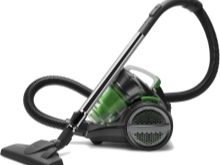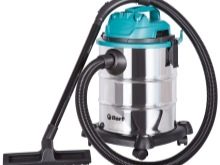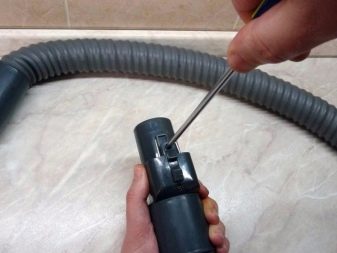Features of vacuum cleaner hose repair

Cleaning an apartment is an important process that not only improves the aesthetic state of the premises, but also makes it safe for human life and health. One of the most important household appliances that helps remove debris, dust, and animal hair is a vacuum cleaner. Modern manufacturers produce a huge amount of these devices, which differ in model, appearance, design and country of manufacture.
The most fragile part of the vacuum cleaner is the corrugated hose. Before using this device, you must carefully read the manufacturer's instructions and do not ignore the simple rules of using a home assistant. Only respect for technology and timely repairs will extend the service life of the device.



Description
A vacuum cleaner is a multifunctional device that helps to clean any room.
On the shelves of modern household stores, you can see floor-standing, hand-held, vertical and built-in appliances.
This device consists of the following elements:
- main body with motor, dust collector and filters;
- corrugated hoses and pipes, which can be both external and internal;
- nozzles for collecting dust and debris.
The vacuum cleaner hose is a corrugated tube made of polypropylene, rubber or plastic. Many devices have iron bar inserts that add rigidity and strength to the structure. Distinctive features - a high level of elasticity and the ability to increase its length. The standard hose length is 150 cm.



Plastic sleeves are installed at both ends of the device. Special nozzles for cleaning are attached to one branch pipe, and the other end is made in the form of a coupling that connects the hose and the main body of the device.
There are a number of basic parameters that influence the choice of hose.
- Diameter - an important indicator on which the suction power depends. For each model of the vacuum cleaner, the manufacturer independently chooses the diameter of the corrugated tube.
- Length - an indicator that affects the convenience of cleaning and the maneuverability of the device.
- Manufacturing material - the main parameter that corresponds to the model of the vacuum cleaner, as well as the method of cleaning (dry or wet).
- Design - an indicator influenced by the purpose and characteristics of the vacuum cleaner. Hoses for washing devices have additional water pipes and triggers, which are fixed with a special latch. To adjust the suction, control panels with a power source are installed.
- Price range - the main indicator that affects the period of operation of the device and its quality.
- Elasticity - a property of the hose that affects the durability and ease of cleaning.



The most common areas of deformation:
- near the handle and at the junction with the main body;
- in the middle of the tube.
Breakdown reasons
The main signs of breakage of a corrugated tube are a decrease in the power and thrust of the apparatus.
Cracks, tears, cuts, punctures and other mechanical damage can significantly reduce the efficiency of the device.
Among the main reasons for the deformation of the flexible part of the vacuum cleaner, experts distinguish the following:
- regular bending and twisting of the tube during cleaning;
- excessive increase in length;
- poor quality of the part;
- sharp temperature fluctuations;
- moving the device with a hose;
- getting into the device of foreign objects;
- contact of the part with sharp objects and corners of furniture;
- violation of storage rules;
- long period of operation;
- mechanical wear.


Repair methods
If the hose breaks, jumps out of the wall chaser, flies out of the adapter, bursts, comes off, clogs or breaks, experts recommend changing the damaged part and not rushing to take the device for repair. Having a minimum set of tools, each owner can independently repair the device.
Basic repair methods for corrugated parts:
- removal of the deformed area;
- imposition of a bandage;
- the use of a thermal method;
- repair of a hose with an electric line;
- temporary attachment of adhesive tapes.


The first option is the simplest way to restore the integrity of the part, which requires a minimum set of tools. To remove the damaged area, make a straight cut at the break, remove the cut off from the end piece, cover the cut line with a sealant and insert the whole hose into the tip.
Many models of vacuum cleaners have collapsible limit switches with nylon bushings. The thread on the sleeve is used to fix the hose. To repair this device, it is necessary to disconnect the clamps, change the annular plug and remove the bushing with a deformed section. After trimming the damaged area, you need to assemble the structure in the reverse order.


The second variant of hose deformation is characterized by the presence of mechanical damage in the form of cuts and ruptures caused by careless use of household appliances. The material for creating the bandage can be ordinary bicycle rubber, which has a high level of elasticity and fits snugly to the hose. The repair process consists of the following stages:
- trimming the damaged area;
- cleaning the end parts of the hose;
- preparing the necessary piece of bicycle rubber, the length of which should be no more than 15 cm;
- attaching a rubber band to the damaged area;
- connecting the ends of the hose using a special adhesive;
- lubrication of the attachment point of the bandage with universal glue;
- tight attachment of a piece of the camera to the hose and secure fixation until the glue is completely dry.


This method makes it possible to reliably and accurately connect the hose, while maintaining the elasticity of its corrugation.
Repairing a corrugated part using a building hair dryer and heat shrinkable material is the most difficult method, which has high reliability and durability. Advantages - no need to remove a deformed piece of hose, the ability to repair any damaged area. The disadvantage is the presence of a special construction hair dryer. The main stages of the repair work:
- selection of heat shrinkable material in accordance with the diameter and color of the hose;
- dismantling the end switch from the undamaged side;
- fixing the thermal material at the rupture site;
- uniform heating of the rubber pad along its entire length.
The installed electrical wires inside the corrugated hose can cause difficulties in repair.

This electrical device is installed on devices that have an air flow control sensor. The peculiarity of the repair is the removal of the damaged area along with the electrical wires, which will require re-connection. Repair activities:
- disassembly of the nozzle body;
- disconnecting the branch pipe from the hose;
- dismantling the defective part of the pipe;
- soldering contact pins to conductors;
- collection of construction.
Among the main disadvantages of this device with an electric control sensor, experts highlight the possible deformation of the hose at the point where it is connected to the handle and the rupture of only electrical wires.
In the absence of special knowledge and tools, it is better to hand over non-working equipment to special repair shops.
For a quick temporary repair, experts recommend using tape, masking tape and electrical tape, which will help close the damaged area for a short period of time.


Stages of repair measures:
- cleaning and degreasing the place where the adhesive is applied;
- fastening the selected adhesive tape in two or three layers;
- fixing the end of the tape with glue.


This design cannot replace a full-fledged repair and has a short operating period, but it can become a quick way to reanimate the device.
Particular attention should be paid to the occurrence of a specific whistle and odor that the hose can emit during operation, as well as a sharp decrease in the suction power. The main reason for this type of breakdown is the presence of a foreign object inside the corrugated pipe. Most often, craftsmen remove small toys, socks, handkerchiefs, paper and plastic bags. Even an inexperienced craftsman can fix this type of problem with his own hands by sticking a thick wire or a piece of reinforcement into a corrugated cavity. Disassemble the device, clean and repair it, pull out the sock, take out the toy, you can get rid of the smell within a few minutes.
For information on how to repair a vacuum cleaner hose with heat shrinkage, see the following video.













The comment was sent successfully.